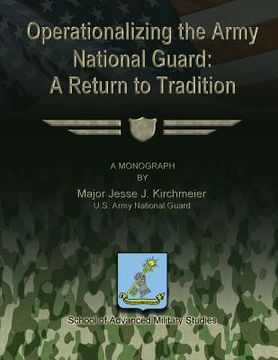Share
Operationalizing the Army National Guard: A Return to Tradition (in English)
Us Army National Guard Majo Kirchmeier
(Author)
·
School Of Advanced Military Studies
(Contributions by)
·
Createspace Independent Publishing Platform
· Paperback
Operationalizing the Army National Guard: A Return to Tradition (in English) - Studies, School Of Advanced Military ; Kirchmeier, Us Army National Guard Majo
$ 13.59
$ 16.99
You save: $ 3.40
Choose the list to add your product or create one New List
✓ Product added successfully to the Wishlist.
Go to My WishlistsIt will be shipped from our warehouse between
Wednesday, July 17 and
Thursday, July 18.
You will receive it anywhere in United States between 1 and 3 business days after shipment.
Synopsis "Operationalizing the Army National Guard: A Return to Tradition (in English)"
The Army announced in the 2006 Army Posture Statement that it had to operationalize the Army National Guard. The decision to operationalize the National Guard was necessary because the Army did not have enough active units to meet requirements for the War on Terrorism. Operationalization of the Army National Guard was a departure from the Cold War force structure. It was not, however, a revolutionary change for the nation's National Guard forces. The research initially focused on determining what was meant by the term "strategic reserve." That research revealed that numerous military commanders, both active and reserve, have used the term in reference to U.S. Army force structure. However, military policy documents and statutes do not define that term. The search for a clear definition of strategic reserve and its meaning for U.S. National Guard structure led to the discovery that the National Guard had only recently been constituted as a strategic reserve. The National Guard did not begin as a strategic reserve. The Guard also has experience as an operational force. The view that the National Guard was only a strategic reserve developed during the Cold War. After the end of the draft, the Department of Defense implemented the "Total Force Policy". That policy started the National Guard's movement back toward operational capability. The research explores the history of the National Guard as the nation's constitutional defense force and its subsequent development into a Federal Reserve. The history reveals that operationalization of the National Guard is not a radical venture for state controlled units. Rather, the Army's use of the National Guard as an operational force is a return to the tradition of state militias participating in the nation's defense. The National Guard serving in an operational role is not unique in the nation's history. The Cold War practice of maintaining separate strategic and operational reserve forces does not meet today's force demands. Security planners have yet to refine post Cold War force and mission definitions. Until the missions are redefined, it was only natural for the Army to use its reserves to reduce stress on active component forces. It is also a mistake to assume the Army suddenly made the reserves operational or that the National Guard has never served in an operational manner. While at times the Army resisted using the Guard, the Guard has a history of serving in an operational role. The Constitution specified that state based militias would serve as part of the country's main defense force. Operationalization of the National Guard is an extension of the policies Congress started under the National Militia Act of 1903. The Army is only continuing these practices with its 2006 Army Posture Statement announcement. Finally, the United States has historically been unprepared for major long-term conflicts. The nation also tends to decrease active component strength following hostilities. These precedents foretell the same once significant combat operations in Iraq and Afghanistan end. As such, equipping and training the National Guard for operational force capability potentially enhances its ability to perform both strategic and operational force functions in the future.
- 0% (0)
- 0% (0)
- 0% (0)
- 0% (0)
- 0% (0)
All books in our catalog are Original.
The book is written in English.
The binding of this edition is Paperback.
✓ Producto agregado correctamente al carro, Ir a Pagar.

